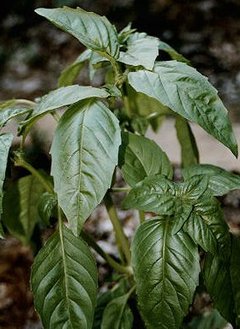Basil
|
|
- This article is about basil the plant and herb. For other uses of the word basil, see basil (disambiguation).
| Basil | ||||||||||||||
|---|---|---|---|---|---|---|---|---|---|---|---|---|---|---|
 Basil | ||||||||||||||
| Scientific classification | ||||||||||||||
|
Basil (Ocimum basilicum, Lamiaceae) is also known as Albahaca, St. Joseph's Wort, and Sweet Basil. It is a tender low-growing annual herb, originally native to tropical Asia. It grows to between twenty and sixty centimetres tall, with opposite, light green, silky leaves 1.5-5 cm long and 1–3 cm broad. It tastes somewhat like cloves, with a strong, pungent, sweet smell. Basil is very sensitive to cold, with best growth in hot, dry conditions.
The word basil comes from the Greek βασιλευς, meaning “king”. The Oxford English Dictionary quotes speculations that basil may have been used in "some royal unguent, bath, or medicine". Basil is still considered the "king of herbs" by many cookery authors.
| Contents |
Basil as a herb
Basilic-spice.jpg
Basil is most commonly used fresh, and in cooked recipes, is generally added at the last moment, as cooking destroys the flavour quickly. The fresh herb can be kept for a short time in plastic bags in the refrigerator, or for a longer period in the freezer, after being blanched quickly in boiling water. Place fresh leaves in a dry jar with a pinch of salt, and cover with olive oil. The dried herb also loses most of its flavour, and what little flavour remains tastes very different, with a weak coumarin flavour, like hay.
Mediterranean cuisines frequently use basil, especially combined with tomato. Basil is one of the main ingredients in pesto - an Italian sauce from the city of Genoa. The most commonly used Mediterranean basil cultivars are 'Genovese', 'Purple Ruffles', 'Mammoth', 'Cinnamon', 'Lemon', 'Globe', and 'African Blue'.
Basil is sometimes used with fresh fruit and in fruit jams and sauces — in particular with strawberries, but also raspberries or dark-colored plums. Arguably the flat-leaf basil used in Vietnamese cooking, which has a slightly different flavour, is more suitable for use with fruit.
When soaked in water the seeds of several basil varieties become gelatinous, and are used in Asian drinks and desserts.
Other basils
Several other basils, including some other Ocimum species, are grown in many regions of Asia. Most of the Asian basils have a clove-like flavour that is generally stronger than the Mediterranean basils. In China, the local cultivar is called "九層塔" ("Nine-Storied Pagoda") in Chinese, while the imported herb is called "羅勒". If the western variety is required, a Chinese cookbook author will specify "羅勒" or "巴西里" instead of "九層塔".
Basil is also very popular in Thai cuisine, which uses two quite different cultivars, generally sold as Thai Basil and Holy Basil (Ocimum sanctum) in the West. Vietnamese and Chinese also use fresh or dried basils in soups and other foods. In Taiwan, people add fresh "九層塔" basil leaves to thick soups (羹湯). They also eat fried chicken with deep-fried "九層塔" basil leaves.
'Lemon basil' has a strong lemony smell and flavour, very different from those of other varieties. It is widely used in Indonesia, where it is called kemangi and served raw, together with raw cabbage, green beans, and cucumber, as an accompaniment to fried fish or duck.
Growing basil
Basil thrives in hot weather, and it should never be grown outdoors if there is any chance of a frost. In Northern Europe, the northern states of the U.S., and the North Island of New Zealand it will grow best if sown under glass in a peat pot, then planted out in late spring/early summer (when there is little chance of a frost). It fares best in a well-drained sunny spot.
Although basil will grow best outdoors it can be grown indoors in a pot and, like most herbs, will do best on a south-facing windowsill. It should be kept away from any draughts, and must be able to get plenty of sunlight, therefore a greenhouse or cloche would be ideal if you have them.
In sunnier climates such as Southern Europe, the southern states of the U.S., the South Island of New Zealand, and Australia, basil will thrive when planted outside. It will need regular watering, but not as much attention as is needed in other climates.
Cultural aspects
ChristianBauer_stalk_of_basil.jpg
African legend claims that basil protects against scorpions. European lore sometimes claims that basil is a symbol of Satan, though in other places, like India, the plant is highly revered. Similarly, it is a symbol of love in present-day Italy, but represented hatred in ancient Greece.
In Boccaccio's Decameron a memorably morbid tale (novella V) tells of Lisabetta, whose brothers slay her lover. He appears to her in a dream and shows her where he is buried. She secretly disinters the head, and sets it in a pot of basil, which she waters with her daily tears. The pot being taken from her by her brothers, she dies of her grief not long after. The story is already told of the Longobard queen Rosalind.
External links
- Selfsufficientish — Basil, Ocimum Basilicum (http://www.selfsufficientish.com/basil.htm) Organic growing, history and more
- Basil: An Herb Society of America Guide (http://herbsociety.org/basil/index.htm)
- Gernot Katzer's Spice Pages (http://www.uni-graz.at/~katzer/engl/Ocim_bas.html) explain the culinary use of basil in European and Asian cooking; further weblinks.bg:Босилек
be:Базылік da:Basilikum (Ocimum basilicum) de:Basilikum es:Albahaca eo:Bazilio fr:Basilic gl:Asubiote nl:Basilicum ja:バジリコ pl:Bazylia pospolita sl:Bazilika fi:maustebasilika sv:Basilika (krydda)
